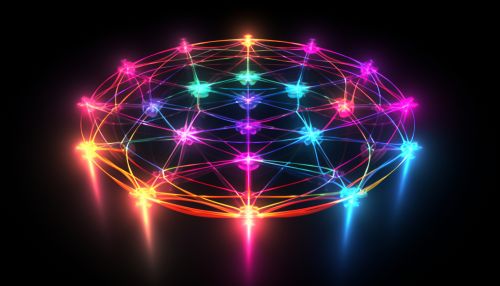Steane's Code
Introduction
Steane's code is a quantum error correcting code, named after its discoverer, Andrew M. Steane. It was the first example of a class of quantum error correcting codes now known as CSS codes, which are notable for their ability to correct both bit flip and phase flip errors.


Background
Quantum error correction is a vital part of quantum computing, as it allows for the correction of errors that occur due to the fragile nature of quantum states. Steane's code is a seven-qubit code, meaning it encodes a single logical qubit in a seven-qubit state. This redundancy allows for the correction of errors that affect any one of the seven qubits.
Description
Steane's code is a quantum error correcting code that encodes a single logical qubit into a seven-qubit state. The code is designed to correct any single-qubit error, which includes both bit flip and phase flip errors.
The code is constructed by choosing a seven-qubit state that is a simultaneous eigenstate of seven operators. These operators are chosen such that any single-qubit error will change the eigenvalues of an even number of operators. By measuring the eigenvalues of these operators, it is possible to determine which qubit (if any) has been affected by an error, and to correct that error.
Error Correction
The error correction process in Steane's code involves two steps: error detection and error correction.
In the error detection step, the seven operators are measured. This measurement does not disturb the encoded qubit state, but it does reveal whether an error has occurred. If an error has occurred, the measurement results will indicate which qubit was affected.
In the error correction step, a correction operation is applied to the affected qubit. This operation depends on the type of error that occurred. For a bit flip error, the correction operation is a bit flip. For a phase flip error, the correction operation is a phase flip.
Properties
Steane's code has several important properties that make it a useful quantum error correcting code.
First, it is a CSS code, which means it can correct both bit flip and phase flip errors. This is a significant advantage over some other quantum error correcting codes, which can only correct one type of error.
Second, it is a stabilizer code, which means it can be efficiently simulated on a classical computer. This makes it useful for studying the behavior of quantum error correction in general.
Third, it is a degenerate code, which means that different errors can lead to the same error syndrome. This property is useful for correcting errors when the error model is not known exactly.
Applications
Steane's code, and CSS codes in general, have found wide application in quantum computing. They are used in quantum error correction schemes to protect quantum information from errors due to decoherence and other quantum noise.
In addition, Steane's code has been used to demonstrate fault-tolerant quantum computation. In a fault-tolerant quantum computer, errors that occur during the computation are corrected on the fly, allowing the computation to proceed despite the presence of errors.
